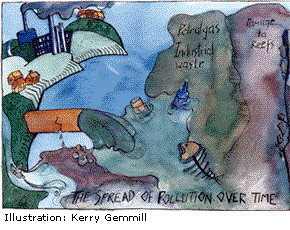The problem

Many of Te Atiawa's reefs were no longer usable by the 1980s because they had been polluted. The pollution had come from sewer outfalls along the coast and also from run-off – farm waste and chemical fertilisers which were washed into streams and rivers and then out to sea.
The worst pollution was from the Waitara Borough outfall, which emptied sewage and industrial waste into the sea near some of the reefs. This outfall was damaged and overloaded, which made the problem worse. In the 1980s, the reefs and the coastal waters were used by the general public as well as Te Atiawa. They were used by fishers, divers, surfers, and swimmers, and for rock scrambling and exploring.
During the hearings on the Motunui–Waitara claim, the Tribunal was told of times when swimmers had caught boils and other skin diseases after swimming in the area, of divers coming out of the sea with toilet paper and other wastes on their bodies, and that the local surf lifesaving club had been forced to shut down.
In 1981, the New Zealand Synthetic Fuels Corporation (Syngas) was given permission to build another outfall for its synthetic fuels plant at Motunui. This outfall would have emptied more sewage and industrial waste onto the reefs and affected the Motunui Reef, which was one of the few safe reefs left for collecting seafood.
The outfall was to be built under strict conditions, but neither Syngas nor the Planning Tribunal, which gave Syngas permission to build the outfall, could guarantee that there would be no further pollution of the reefs.
It was at this point that Te Atiawa made their claim to the Waitangi Tribunal.
Next: The Claim Made to The Waitangi Tribunal
This page was last updated: